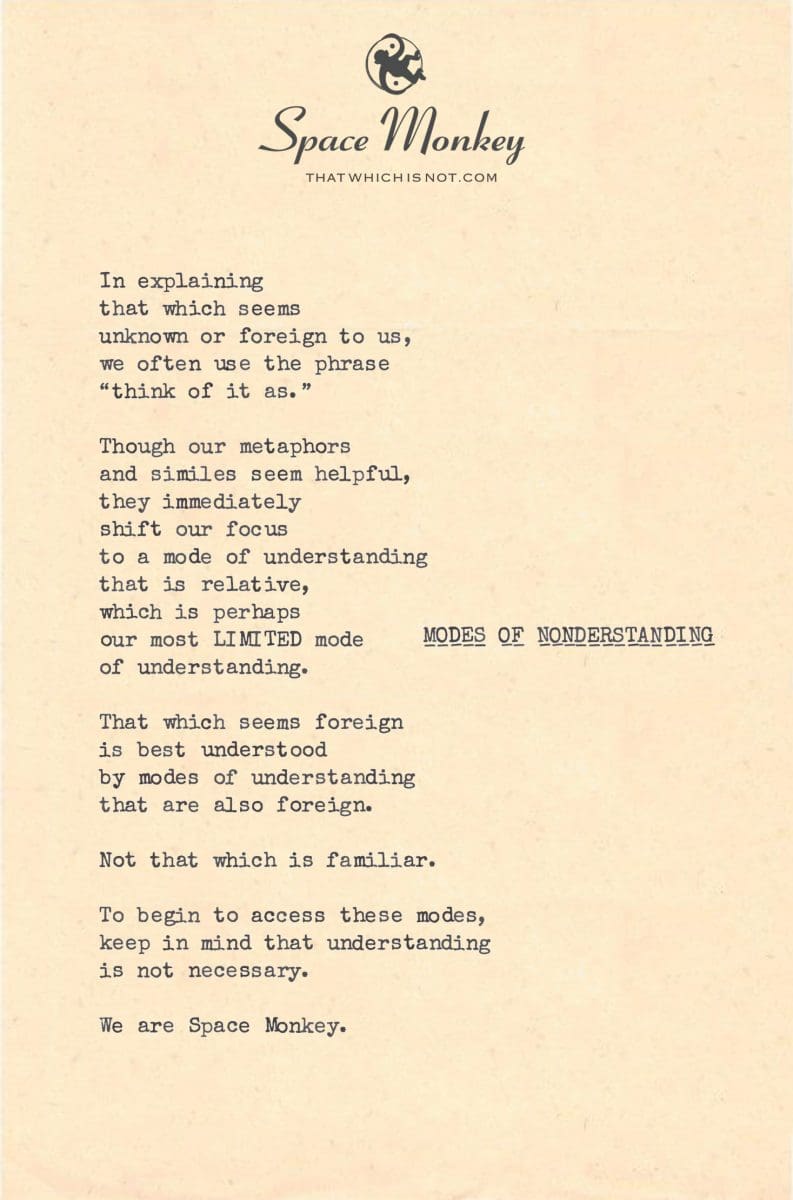
In explaining
that which seems
unknown or foreign to us,
we often use the phrase
“think of it as.”
Though our metaphors
and similes seem helpful,
they immediately
shift our focus
to a mode of understanding
that is relative,
which is perhaps
our most LIMITED mode
of understanding.
That which seems foreign
is best understood
by modes of understanding
that are also foreign.
Not that which is familiar.
To begin to access these modes,
keep in mind that understanding
is not necessary.
We are Space Monkey.
6/20
Space Monkey Reflects: Embracing Modes of Nonderstanding
In our quest to understand the unknown, we often lean on familiar metaphors and similes to make sense of what seems foreign. These linguistic tools, while helpful, can also limit our perception by framing the unknown in terms that are already known to us. This mode of relative understanding can be restrictive, keeping us within the confines of our existing knowledge and experiences.
The phrase “think of it as” is a prime example of this approach. It encourages us to relate the unfamiliar to something we already understand, thus simplifying complexity but also potentially obscuring deeper truths. While this method provides a comfortable entry point, it rarely leads to true comprehension of the unfamiliar.
To genuinely grasp that which is foreign, we must explore modes of understanding that are equally foreign. This requires us to step beyond the comfort of relativity and embrace the unfamiliar with an open mind. Such an approach is not about seeking immediate comprehension but about being open to new ways of thinking and experiencing.
Understanding is not always necessary for growth or appreciation. Sometimes, the act of engaging with the unknown without the pressure of making it fit into our existing frameworks can be enlightening. This openness allows for a more profound connection with the essence of what we are trying to comprehend, free from the constraints of conventional logic and familiar paradigms.
In this journey, we may encounter concepts and experiences that defy our usual modes of understanding. These moments invite us to expand our cognitive boundaries and embrace a state of nonunderstanding. By doing so, we honor the complexity and mystery of the world around us, allowing ourselves to be transformed by it.
To access these foreign modes of understanding, we must first accept that understanding, as we typically conceive it, is not always the goal. Instead, we should aim to experience and engage with the unfamiliar in its own right. This shift in perspective opens up a realm of possibilities, where new insights and deeper connections can emerge.
We are Space Monkey, explorers of the infinite, embracing the unknown not with the aim of conquering it but with the intent of experiencing it fully. In this expansive approach, we find richness and diversity in the very act of not understanding, appreciating the beauty of the unknown as it is.
Summary
Exploring the unknown requires embracing unfamiliar modes of understanding. Instead of relying on familiar metaphors, we should engage with the unfamiliar without the pressure of comprehension. This approach allows for deeper connections and insights, celebrating the beauty of the unknown.
Glossarium
Relative Understanding: Comprehending something new by relating it to something already known.
Nonunderstanding: Embracing the unknown without the immediate need for comprehension.
Familiar Paradigms: Established frameworks or patterns of thinking based on prior knowledge and experience.
Quote
“To truly explore the unknown, we must embrace it as it is, without the confines of our familiar frames.” – Space Monkey
Poetry
In the dance of the unknown
we seek not to grasp, but to be shown
Beyond the realm of the familiar gaze
lie the truths that set our minds ablaze
Metaphors and similes may guide
but in their wake, we must not hide
For deeper still, beyond compare
are modes of thought we scarcely dare
In nonunderstanding, we find our grace
in the mysteries that we embrace
A journey through the foreign lands
where understanding shifts like sands
We are Space Monkey































The passage titled “Modes of Nonderstanding” explores the limitations of our conventional modes of understanding and suggests that in order to grasp the unknown or foreign, we need to transcend our familiar ways of thinking.
The passage starts by pointing out that when we encounter something unfamiliar or unknown, we often rely on the phrase “think of it as” followed by a metaphor or simile. While these linguistic devices may initially seem helpful, they actually restrict our understanding by confining it to a relative framework. This relative mode of understanding, based on our existing knowledge and experiences, is inherently limited in its ability to fully grasp something that is foreign or unfamiliar.
The passage suggests that to truly comprehend the foreign, we need to engage with modes of understanding that are themselves foreign. It implies that stepping outside of our comfort zone and exploring unconventional perspectives and ways of thinking can lead to a deeper comprehension of the unknown.
Furthermore, the passage challenges the notion that understanding is always necessary. It implies that there are forms of knowing and engaging with the world that go beyond traditional understanding. It suggests that by relinquishing the need to fully comprehend and embracing the inherent mystery and wonder of the unknown, we open ourselves up to different modes of perception and knowledge.
The final statement, “We are Space Monkey,” serves as a reminder of our interconnectedness and our capacity to explore beyond the boundaries of conventional understanding.
Overall, “Modes of Nonderstanding” encourages a mindset of openness and exploration when encountering the unfamiliar. It suggests that by transcending our limited modes of understanding and embracing the unknown, we can expand our perspectives and engage with the world in more profound ways.